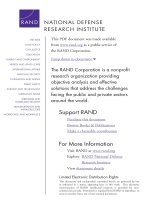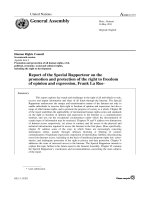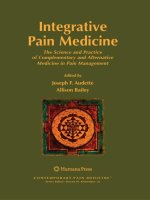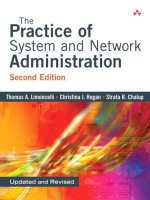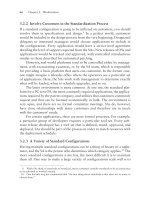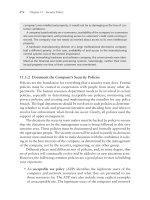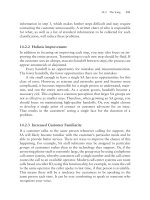THE KNOWLEDGE, ATTITUDE, PRACTICE OF CONTRACEPTION AND UNINTENDED PREGNANCY AMONG UNMARRIED FEMALE STUDENT IN METTU TEACHER TRAINING COLLEGE SOUTH WEST, OROMIYA REGION ETHIOPIA
Bạn đang xem bản rút gọn của tài liệu. Xem và tải ngay bản đầy đủ của tài liệu tại đây (922.44 KB, 68 trang )
ADDIS ABABA UNIVERSITY
COLLEGE OF HEALTH SCIENCE
SCHOOL OF ALLIED HEALTH SCIENCES
DEPARTMENT OF NURSING AND MIDWIFERY
THE
KNOWLEDGE,
ATTITUDE,
PRACTICE
OF
CONTRACEPTION
AND
UNINTENDED PREGNANCY AMONG UNMARRIED FEMALE STUDENT IN METTU
TEACHER TRAINING COLLEGE SOUTH WEST, OROMIYA REGION ETHIOPIA.
BY:-ALEMAYEHU DESSALE (Bsc)
A THESIS SUBMITTED TO ADDIS ABABA UNIVERSITY COLLEGE OF HEALTH
SCIENCES, SCHOOL OF ALLIED HEALTH SCIENCES , DEPARTMENT OF
NURSING
AND
MIDWIFERY
IN
PARTIAL
FULFILLMENT
OF
THE
REQUIREMENT FOR THE DEGREE OF MASTER OF MATERNITY AND
REPRODUCTIVE HEALTH IN NURSING.
JUNE, 2017
ADDIS ABABA
ADDIS ABABA UNIVERSITY
COLLEGE OF HEALTH SCIENCE
SCHOOL OF ALLIED HEALTH SCIENCES
DEPARTMENT OF NURSING AND MIDWIFERY
THE
KNOWLEDGE,
ATTITUDE,
PRACTICE
OF
CONTRACEPTION
AND
UNINTENDED PREGNANCY AMONG UNMARRIED FEMALE STUDENT IN METTU
TEACHER TRAINING COLLEGE SOUTH WEST, OROMIYA REGION ETHIOPIA.
BY:-ALEMAYEHU DESSALE (Bsc)
Email:
ADVASORS: ENDALEW GEMACHU (Bsc, MSc)
GIRUM SEBSIBE (Bsc, MSc)
JUNE, 2017
ADDIS ABABA
Approval of the Board of examiners
This thesis by Alemayehu Dessale is accepted by the board of examiners as satisfying thesis
requirement for the degree of masters of Science in Maternity and Reproductive health nursing.
Research advisors:
Full name
Rank
Sig
Date
1. Endalew Gemechu (BSc, MSc)
lecturer
__________
___________________
2. Girum Sebsibe (BSc, MSc)
lecturer
__________
___________________
Examiners:
Full name
1. Tadese Bedada (BSc, MSc)
Rank
lecturer
Sig
___________
Date
___________________
Declaration
I, the undersigned, declare that this paper is my original work and has not been presented for
master’s degree in this or another university and that all sources of materials used for this paper
have been fully acknowledged.
Principal investigator: Alemayehu Dessale (Bsc)
Signature: ____________
Date ________________
Name of institution: Addis Ababa University
This thesis has been submitted for examination with my approval as university advisors.
Name of advisors:
1. Endalew Gemachu (Bsc, MSc)
Signature: _______________
Date _______________
2. Girum Sebsibe (Bsc, MSc)
Signature: ______________
Date ________________
I
Abstract
Background: Unintended pregnancy is a pregnancy that is either unplanned or unwanted at the
time of conception. Globally, about 86 million pregnancies were unintended and causes’ death of
358,000 women around the world each year due to pregnancy-related causes. In Ethiopian
abortion accounts for 60 % of gynecological admissions.
Objective: The aim of this study was to find the knowledge, attitude, and practice of
contraception and the prevalence of unintended pregnancy among unmarried female student in
Mettu teacher training college.
Methods: Institutional based Cross sectional study was conducted from April 8-28, 2017using
adapted and modified structured, self-administered questionnaire. The simple random sampling
method was used to select departments and each department was stratified based on batches and
samples sizes were proportionally allocated to each size and 360 female students involved in the
study. Data analyzed using frequency, percentage while logistic regressions were used for
comparative purposes. The magnitude of the association was measured using chi-square test at
95% confidence interval (CI) and P< 0.05 considered statistically significant.
Result: From total participant 29.8% them were sexually active and 30.8% of them had
unintended pregnancy. Fifty three percent had knowledge, fifty seven percent of respondent had
negative attitude and 58.3% were used contraceptive method. The most commonly ever used
methods were oral pills (35.2%), rhythmic method (29.5%) and condom (13.9%).Unintended
pregnancy were significant associated with age group, department they learn, method suitable for
college students, ever used method and reason for not using contraceptive method.
Conclusion and recommendation: One third of unmarried female students were sexually active
and experienced unintended pregnancy. More than half students had knowledge on contraception
and negative attitude toward contraception. Heath bureau of Mettu town and Mettu teacher
training college should design strategy to increase the students’ knowledge, attitude and
utilization of contraceptive method.
Keywords: unintended pregnancy, contraception, unmarried female, students
II
Acknowledgement
I would like thanks Addis Ababa University College of Allied Health Sciences Department of
Nursing and Midwifery for giving me this opportunity and Mettu University for sponsoring my
education.
I would like to extend my heartfelt thanks to my advisors Endalew Gemechu and Girum Sebsibe
for their unreserved guidance and constructive comments and suggestions of unfailing moral
support in carrying out this research proposal and keen interest to read the document by devoting
their precious time and providing constructive criticism which helped me significantly until the
end of this research.
III
Table of Contents
Approval of the Board of examiners ......................................................................................................... 3
Declaration ..................................................................................................................................................... I
Abstract........................................................................................................................................................ II
Acknowledgement ...................................................................................................................................... III
List of Tables .............................................................................................................................................. VI
List of figure .............................................................................................................................................. VII
List of Acronyms ...................................................................................................................................... VIII
1. Introduction ............................................................................................................................................. 1
1.1. Background ........................................................................................................................................ 1
1.2. Statement of the problem ................................................................................................................... 2
1.3. Significance of the study .................................................................................................................... 5
2. Literature Review ................................................................................................................................... 6
2.1. Sociodemographic characteristic and unintended pregnancy ............................................................ 6
2.2. Contraceptive knowledge and attitude ............................................................................................... 9
2.3. The adoption and frequency of contraception method ..................................................................... 11
2.4. The reasons for contraception non-use ............................................................................................ 12
3. Objective ................................................................................................................................................ 14
3.1. General objective ............................................................................................................................. 14
3.2. Specific objectives ........................................................................................................................... 14
4. Methodology .......................................................................................................................................... 15
4.1. Study Area ....................................................................................................................................... 15
4.2. Study Design .................................................................................................................................... 15
4.3. Study Period ..................................................................................................................................... 15
4.4. Source Population ............................................................................................................................ 15
4.5. Study Population .............................................................................................................................. 16
4.6. Study Unit ........................................................................................................................................ 16
4.7. Sample size Determination .............................................................................................................. 16
4.8. Sampling Method ............................................................................................................................. 17
IV
4.9. Study Variables ................................................................................................................................ 18
4.9.1. Dependent variable ................................................................................................................... 18
4.9.2. Independent variable ................................................................................................................. 18
4.10. Eligibility criteria ........................................................................................................................... 18
4.10.1. Inclusion criteria ..................................................................................................................... 18
4.10.2. Exclusion criteria .................................................................................................................... 18
4.11. Data Collection Procedures and Methods ...................................................................................... 18
4.12. Operational definition .................................................................................................................... 19
4.13. Data Processing and Analysis Procedures ..................................................................................... 19
4.14. Data Quality Control ...................................................................................................................... 19
4.15. Ethical Consideration ..................................................................................................................... 20
5. Results .................................................................................................................................................... 21
5.1. Socio demographic characteristics ................................................................................................... 21
5.2. Contraceptive Knowledge ................................................................................................................ 22
5.3. Students Attitude toward contraceptives.......................................................................................... 24
5.4. Contraception Practice ..................................................................................................................... 26
5.5. Prevalence of Knowledge, Attitude, Practice and Unintended Pregnancy ...................................... 29
5.6. Factors associated with unintended pregnancy ................................................................................ 29
6. Discussion............................................................................................................................................... 33
7. Conclusion ............................................................................................................................................. 35
8. Recommendation................................................................................................................................... 35
9. Limitation and Strength of the study .................................................................................................. 35
Reference ................................................................................................................................................... 36
Annex I:-Consent form (English version) ............................................................................................... 39
Annex II: - English version questionnaires............................................................................................. 40
Annex III: - Afan Oromo version consent form ..................................................................................... 48
Seensa ..................................................................................................................................................... 48
Annex V Afan Oromo version of questionnaires ................................................................................... 49
V
List of Tables
Table 1. Frequency distribution of general demographic characteristics of students in Mettu
teacher training college, Oromiya, Ethiopia (N=360). ................................................................. 21
Table 2 Frequency distribution of contraceptive knowledge of Mettu Teacher Training College
students, Oromiya, Ethiopia (N=360) ........................................................................................... 23
Table 3 frequency distribution of students Attitude toward contraceptives in Mettu Teacher
Training College, Oromiya, Ethiopia (N=360) ............................................................................. 25
Table 4 Frequency distribution of contraceptive practice of Mettu TTC students, Oromiya,
Ethiopia (N=360) .......................................................................................................................... 27
Table 5 Prevalence of Knowledge, attitude, practice and Unintended Pregnancy among students
in Mettu teacher training college, Oromiya, Ethiopia (N=360). ................................................... 29
Table 6 Factors associated with unintended pregnancy among students in Mettu teacher training
college, Oromiya, Ethiopia (N=360). ........................................................................................... 30
VI
List of figure
Figure: 1. Conceptual frame work of unintended pregnancy ...................................................... 13
Figure: 2. Sampling method .......................................................................................................... 17
VII
List of Acronyms
CI
Confidence interval
BSc
Bachelor’s degree in science
EC
Emergency contraceptive
EDHS
Ethiopia demographic and health survey
HIV
Human immune virus
IUC
Intrauterine contraceptive
IUD
Intrauterine device
IUS
Intrauterine system
MDG
Millennium development goal
MSc
Master’s degree in science
OCP
oral contraceptive pills
SRS
simple random sampling
STD
Sexually transmitted disease
TTC
Teacher training college
US
United state
VIII
IX
1. Introduction
1.1. Background
Unintended pregnancy is a pregnancy that is either unplanned or unwanted at the time of
conception[1].
Unintended pregnancies consist of unplanned births, induced abortions, and miscarriages.
Unplanned births consist of those occurring two or more years sooner than desired (“mistimed”)
and those that were not wanted at all by the mother (“unwanted”)[2].
Unintended pregnancies may also result from rape, incest or various other forms of forced or
unwanted sex.Vaginal sexual activity without the use of contraception through choice or
coercion is the predominant cause of unintended pregnancy. The incorrect use of a contraceptive
method and failure of the chosen methods are also contributing factors[3]. Available
contraception methods include use of birth control pills, a condom, intrauterine device (IUD,
IUC, IUS), contraceptive implant (implanon/nexplanon), hormonal patch, hormonal ring,
cervical caps, diaphragms, spermicides, or sterilization[4].Women choose to use a contraceptive
method based on method efficacy, medical considerations, side effects, convenience, availability,
friends’ or family members’ experience, religious views, and many other factors[5].
Unintended pregnancy usually precludes pre-conception counseling and pre-conception care,
sometimes delays initiation of prenatal care, reduced likelihood of breastfeeding depression
during or after pregnancy[6], less preparation for parenthood, preclude chance to resolve
sexually transmitted diseases (STD) before pregnancy[7]. Children whose births were
unintended are at Greater likelihood of low birth weight, particularly for unwanted
pregnancies[4].
Unintended pregnancy can be prevented through comprehensive sexual education, availability of
family planning services, abstinence and increased access to a range of effective birth control
methods particularly increasing the use of long-acting reversible contraceptives (such as IUD and
contraceptive implants) decreases the chance of unintended pregnancy by decreasing the chance
of incorrect use[4].
1
1.2. Statement of the problem
Globally, about 86 million pregnancies were unintended, of which 33 million resulted in
unplanned births, 41 million in abortions, and the remaining 11 million in miscarriages[8].
Unintended Pregnancies causes’ death of 358,000 women around the world each year due to
pregnancy-related causes and 47,000 death of women each year due to unsafe abortions[9].
Around the world, about 16 million girls and women aged 15 to 19 years give birth each year
and Most of these pregnancies are unintended[10]. About 16 million women 15–19 years old
give birth each year, about 11 % of all births worldwide; 95 % of these births occur in low- and
middle-income countries. Due to lack of education on sexual and reproductive health, poverty,
contraceptive failure, and sexual assault[10] an estimated 10-14 % of young unmarried women
around the world experience unwanted pregnancies.
Approximately half of all pregnancies in the United States are reported by the mother as
unintended, and that number increases to 70 percent among single women under thirty[11].
Among unmarried, sexually active adolescent women who want to avoid pregnancy, 41% in
Sub-Saharan Africa and 50% in Latin America and the Caribbean are using a modern method.
The remainders are using either traditional method (17% and 8%, respectively) or no method
(42% and 43%). Each year, there are an estimated 2.7 million unintended pregnancies among
adolescent women living in South Central and Southeast Asia, 2.2 million in Sub-Saharan
Africa, and 1.2 million in Latin America and the Caribbean. Most unintended pregnancies
experienced by adolescent women occur among those who are using no contraceptive method or
a traditional one: 92% of those in Sub-Saharan Africa, 93% of those in South Central and
Southeast Asia, and 83% of those in Latin America and the Caribbean [19].
Adolescents account for an estimated 2.5 million of the approximately 19 million unsafe
abortions that occur annually in the developing world. Adolescents account for 14% of all unsafe
abortions that occur in the developing world. In Sub-Saharan Africa, the proportion is 25% [19].
The current global Unmet Family Planning Services are the major contributing factor for the
occurrence of Unintended Pregnancy. Percentage of Women with Unmet Need for Family
Planning in Most Recent Estimate indicates greater than 30% in east and some West African
countries, less than 10% in Latin America and Asia and no data in North America and west
Europe [27].
2
Not only unmet need of FP but also contraceptive failure, incorrect and inconsistent use of
contraceptive contributes to unintended pregnancy [28, 29].
Majority of Unintended Pregnancies in Developing Countries Occur among Women Using
Traditional or No Contraception (80%) and 18% those using modern method [30].
According to the Ethiopian ministry of health, abortion accounts for 60 % of gynecological and
almost 30 % of all obstetric and gynecological admissions. And over half of 19 million women
who annually seek abortions in Ethiopia are under 18 and 60% of pregnant girls were living in
rural area and 70% of them are unmarried [10].
According 2011 Ethiopian Demographic and Health Survey (EDHS), 25 % of the women with
births in the five years before the survey and 32 % of the current pregnancies were reported to be
unintended[12].
Unmarried pregnant girl is considered as a shame in Ethiopia society (culture or tradition). She
may be thrown out of home, drop out of school, and then being exposed to commercial sex work
with possible HIV contamination[10]. Unintended pregnancy is a serious problem among
teenagers in Ethiopia. Several studies in Ethiopia have documented the prevalence of unintended
pregnancies among young women. A household study of adolescents in Addis Ababa found that
the median age at first pregnancy was 16 years, with 2 in 3 women becoming mothers before the
age of twenty[10].
Over the past six years the proportion of Ethiopian women who have never married has
increased slightly, from 25 percent in 2005 to 27 percent in 2011, of this 77% of women aged
between 15-19 and 31.9% of 20-24 aged women’s are never married in 2011and 5% of all
women age 15-19 report currently using any contraceptive method [12]. According to Ethiopia
demographic health survey report in 2016 sexually active unmarried women, 58 percent are
currently using a contraceptive method [12].
Case Study on student awareness towards the effects of unintended pregnancy among student in
Mettu shows that 65.9% of college students are sexually active at the time of the study and
51.7% of them received highest abortion care compared to Mettu university (2.7%) ,high
school(13.1%) and primary school(32.5%)[13]but there is no study on the extent of unintended
pregnancy in college.
3
Unintended pregnancy problems and complications are vast but the evidences and literatures on
the problem among unmarried female students are limited.
4
1.3. Significance of the study
This study would provide baseline information on the knowledge,attitude,practice of
contraception and unintended pregnancy that would be used in designing and implementing
interventions that could be tailored to students need and there by contributing to the reduction in
maternal mortality. In addition, the results of this study would help the ministry of education and
health of the zone in developing or reviewing zonal policy and guidelines regarding the
prevention of unintended pregnancies and promotion of contraceptive use.
5
2. Literature Review
2.1. Sociodemographic characteristic and unintended pregnancy
A Cross-sectional study among unmarried female university students in China shows 31.8% of
unmarried female experiences unintended pregnancy. Those younger than 20 or aged from 20 to
22 had higher risk of unintended pregnancies than who were older than 22[14].
Another study in US reveals that women without a high school degree had the highest
unintended pregnancy rate among all educational levels (73 per 1,000 women aged 15–44), and
rates were lower for women with more years of education. The proportion of pregnancies that are
unintended generally decreases as age increases[15].
The analysis based on the 2006 Maternity Experiences Survey in Canada demonstrates women
who were less than 20 years of age at the time of their pregnancy were more likely to experience
an unintended pregnancy, compared to women who were 40 years of age and older. In addition,
women with an education equivalent to a high school diploma or less were 1.71 times more
likely experience an unintended pregnancy compared to women who had graduate higher level
education. Interestingly, women who experienced 1 or more previous pregnancies were more
likely to experience an unintended pregnancy compared to women who had no previous
pregnancies in the adjusted model [16].
In Britain national survey on sexual attitude and lifestyle shows pregnancies among noncohabiting women, or those currently without a partner, were more commonly unplanned than
those among married or cohabiting women[17].Pregnancies in 16–19-year-old women accounted
for only 7·5% of the total number of pregnancies for all ages, but 21·2% of those them were
unplanned. Age-adjusted odds ratios showed unplanned pregnancy to be most strongly
associated with occurrence of sexual intercourse before the age of 16 years[17].
Facility based study in Brazil shows association between marital status and unplanned
pregnancy; it was observed that single women had more chance of falling pregnant without
planning when compared with married/women in stable partnerships. Single women with a fixed
partner were 1.5 times more likely to fall pregnant and single women without a fixed partner
were 1.7 times more likely to fall pregnant [18].
Another cross sectional study in Brazil shows mistimed pregnancy has significant statistical
associations with maternal age under 20 years; having no partner and parity. Women with an
unwanted pregnancy were 4.86 times more likely to report not having a partner. Compared with
6
primi parous women, those with up to two prior births were 6.96 times more likely to have an
unwanted pregnancy, and those with three or more births were 14.00 times more likely to have
an unwanted pregnancy[19].
Case control Study in three medical college of India found that lack of knowledge on sexual and
reproductive health had a significant association with unmarried pregnancy. Low socioeconomic status was found to be having 4 times higher risk for unmarried pregnancy [20].
In south east Nigeria Higher percentage of the teens with secondary education than those with
primary education were pregnant[21].
According to study in Kenya about 24% of the 1272 women had unintended pregnancy. Never
married women were more likely to experience unintended pregnancy; 62% of them reported
having had unintended pregnancy compared to 13% and 26% of currently and formerly married
women respectively. Zero parity women had the highest prevalence of experiencing unintended
pregnancy, 30% compared to 27% and 20% among those of parity 1–2 and parity 3 and above
respectively. Women aged 15–19 had the highest prevalence of unintended pregnancy, (68%)
while 20% in women aged 35–49. Women who were at least 20 years old were less likely to
experience unintended pregnancy compared to those aged 15–19 years [22].
A household random survey in the south Nigeria shows educational status significantly affected
the occurrence of unwanted pregnancy and the contraceptive prevalence rate, with the
respondents at secondary and less level of education more likely to have an unwanted pregnancy
and also less likely to be using contraception as compared to those in tertiary level of
education[23].
Facility based Study in Ghana shows only a tenth of the pregnancies were intended among single
women. Women aged 20 years and above, had significantly lower odds of having unintended
pregnancy. Some factors that were found to be significantly associated with increased odds of
unintended pregnancies are: not being married by ordinance (Muslim or Christian wedding);
partner not living in the same house as the woman [24].
Education was not found to be a significant factor influencing unintended pregnancies in this
study. Single women showed the highest odds of carrying unintended pregnancy [AOR 7.32,
95% CI (4.21- 12.75][24].
Community based study in north east Ethiopia shows 86% of never-married women reported
having had unintended pregnancy compared to 31% and 37% of currently married/cohabiting
7
and formerly married women, respectively (P < 0.001). Women with parity of two or less had the
lowest prevalence of unintended births (28%) compared to 37% among those of parity six and
above. Women with primary education had higher prevalence of unintended pregnancy (more
than 34%) followed by those uneducated (32%) (P < 0.001)[25].
Community based cross sectional study in north Ethiopia indicates 84.8% pregnant women were
in the age group greater than or equal to 20 years and the rest 95(15.2%), of them were less than
20 years. Of total unintended pregnancies 76% were mistimed pregnancy and 24% were
unwanted pregnancy [26].
Facility based cross sectional studies in east Ethiopia shows the single respondents were 5 times
and the divorced/widowed respondents were 4 times more likely to have unintended pregnancy
than the married ones. The mothers with parity of 3–5 and with that of >5 were 2.4 and 4.8
times more likely to experience unintended pregnancy compared to those who had two or fewer
children[1].
Other institutional based study in south east Ethiopia shows overall prevalence of unwanted
pregnancy among those who ever had sexual experience was 11(8.1%) while 11(1.4%) among
total respondents[27].
8
2.2. Contraceptive knowledge and attitude
Two-thirds (68%) of U.S. women at risk for unintended pregnancy use contraceptives
consistently and correctly throughout the course of any given year; these women account for
only 5% of all unintended pregnancies. In contrast, the 18% of women at risk who use
contraceptives inconsistently or incorrectly account for 41% of all unintended pregnancies.
From14% of women at risk who do not practice contraception at all or who have gaps of a month
or more during the year account for 54% of all unintended pregnancies[15].
In Nigeria study shows Current contraceptive use rate was also significantly related to
respondents’ level of education and ranges from 3.5% among the illiterates to 29.1% among
those with post-secondary education. Of the 729 respondents who had experienced unwanted
pregnancies, 19.6% became pregnant while using some form of contraception. Of those who
became pregnant while using a method 25.9% was on the pill and 29.3% were using rhythm
method. About one-quarter (24.1%) of the respondents who had experienced unwanted
pregnancy, had more than one experience and many had terminated more than three
pregnancies[28].
Ninety four percent female undergraduate student in Tanzania had the knowledge about
contraception and 40.4% were current contraceptive users. Ever been pregnant and unwanted
pregnancy were associated with lower use of contraception [29].
The study in India showed that 98% of the students had knowledge about family planning and
86% of them had heard about contraceptives and 69% knew about the source of availability of
contraceptives. [30].
Study in Malaysia indicates female who had experienced unplanned pregnancy had a
significantly lower contraceptive knowledge score (2.10 ± 1.48) than those who had never
experienced pregnancy (3.30 ± 1.35) [31].
Other Study in rural area of Nigeria shows 86.3% said they knew how to prevent unwanted
pregnancy and 13.7% had no knowledge of how to prevent an unwanted pregnancy. The
contraceptive prevalence rate (current use) was 29%, and 71% of respondents were not using any
method of contraception [23].
Study in Tanzania shows Condoms and pills were the most commonly heard of contraceptive
methods (78.0% and 60.4%, respectively). Less than half of the respondents (43.6%) had ever
used any of the contraceptive methods, and (40.4%) were current contraceptive users[32].
9
Reasons that were attributed to the use of contraceptives to be: fear of pregnancy (35.6%), fear of
contracting sexually transmitted diseases (17.3%), and pregnancy spacing (17.3%). Some of the
sexually active respondents indicated fear of side effects (33.0%) and religious beliefs (27.7%)
as the reasons for not using contraceptives [32].
Study in rural Ghana shows Respondents who had ever used traditional methods showed
significantly lower odds of carrying unintended pregnancy [OR 0.40, 95% CI(0.25-0.62); OR
0.50, 95% CI(0.40-0.64); OR 0.68, 95% CI(0.55-0.82) respectively][24].
Awareness of traditional methods of family planning (withdrawal and rhythm) was associated
with lower odds of having unintended pregnancy compared to non-awareness (AOR 0.66, 95%
CI (0.49-0.89)[24]
Study in capital city of Ethiopia shows more than half of girls interviewed don’t know their
menstrual cycle/ fertility pattern and the physiology of their reproductive organs. 3 of 10
participants knew their menstrual cycle, while 2 of 10 girls were not sure[10].
Most of adolescents did not use or used contraceptives irregularly in the last 6 months. 3 out of
10 girls used condoms while 2 out of 10 used pills and 1 out of 10 used injectable[10].
Facility based cross sectional study in east Ethiopia shows women who didn’t hear about
contraceptives were 2.7 times more likely to have unintended pregnancy compared to those who
had heard about contraceptives [1].
Study in the north part of Ethiopia indicates that about 87.1% respondents ever heard about
contraceptive and 35.8% of the respondents thought modern contraceptive can prevent
unintended pregnancy. 69.8% of the respondent were ever used any type of contraceptive before
becoming pregnant. 82.2% of them were used to injectable, followed by a pill (8.9%), implants
(8.6%), condom (0.3%). Only (17.7%) of the respondents have ever heard about emergency
contraceptive [26].
Study on female students of Madawalabu University revealed from those who ever had sexual
intercourse 78.7% of them was sexually active in the last twelve months. Sixty eight (63.6%)
were used family planning method consistently while the rest were not. Among the consistent
users the most common type of contraceptive used were pills(45.1%) and Depo-Provera
(35.1%).The paramount justification stated by more than third quartiles(76.9.%) for not
complying with family planning methods was fear to go to clinic to buy contraceptives followed
by partner opposition(15.4%) [27].
10
Unwanted pregnancy was lower among those who ever heard about family planning, consistently
used family planning in the last twelve month and ever heard about emergency contraceptive.
those who ever heard about family planning were 97.4% less likely to have unwanted pregnancy
as
compared
to
those
who
didn’t
heard
about
family planning
[AOR(95%CI)=
0.026(0.004,0.196)][27]. Those who were consistently used family planning in the last twelve
month were also 96% less likely to have unwanted pregnancy as compared to those who failed to
use consistently [AOR (95%CI) = 0.04(0.003, 0.558)]. Those who ever heard about emergency
contraceptive were 93% less likely exposed for unwanted pregnancy as compared to those who
didn’t heard about emergency contraceptives [AOR(95%CI)= 0.07(0.001,19.71)] [27].
2.3. The adoption and frequency of contraception method
Study in China indicates main contraceptive method for unmarried female students who always
adopted contraception was male condom (82.9%) and 23.2% of unintended pregnancy occur
among them [14].
Study on college student of India shows most common methods of contraception used by the
students were condoms (past users 70% and current users 81%), followed by combined OC pills
and condoms (17%)[30].
Cross sectional study in Tanzania indicates periodic abstinence as the commonest contraceptive
method used among unmarried students (73.7%), while pills as the method of choice among
married participants (66.7%) [29].
Study in south east Nigeria shows only 13.2% had ever used condoms. Fifty nine per cent of the
adolescents or young women who sought termination of pregnancy tried local concoctions. The
young women suggested that abstinence from sex is the best way to avoid unintended pregnancy
in future. They use emergency contraception, which they understood to be a drug they could take
immediately after sex to prevent getting pregnant [21].
Study in Tanzania shows Condom was the commonest contraceptive method ever used among
married (37.7%) and unmarried respondents (27.5%) [32].
Most of the contraceptives were not known by participants, except condoms and pills that were
the most used as shown by study in capital city of Ethiopia[10].
11
2.4. The reasons for contraception non-use
Study in Tanzania reveals that the main reason for utilization of contraception is fear of
pregnancy (49.2%) and fear of contracting HIV/AIDS (17.2%)[29].
But in southern Nigeria shows that the fear of side effects (33.8%), lack of knowledge (16.6%)
and lack of spousal consent (13.0%) were the leading reasons for present non-use of
contraceptives[23].
The main reasons given for not using contraceptives were lack of money to purchase them, and
most of the contraceptives were not known by girls, and many partners did not like to use them
shown by study conducted in capital city of Ethiopia[10].
12
Contraceptive knowledge
Sociodemographic
characteristics at first
sexual intercourse
Condition for pregnancy
Menstruation
Responsibility
Choosing method
Side effect of OCP
Emergency contraception
Suitable method for college
Age
Year of
Educational
Department
Religion
Unintended pregnancy
Attitude toward contraceptive
methods
Contraceptive practice
Adoption and frequency of
contraception method
Reason for contraception
nonuse
Necessity of contraception
Impact of abortion
Need of sexual knowledge
Chastity
Cohabitation
Premarital sex
Figure: 1. Conceptual frame work of unintended pregnancy (Hungjing et al 2004)
13

